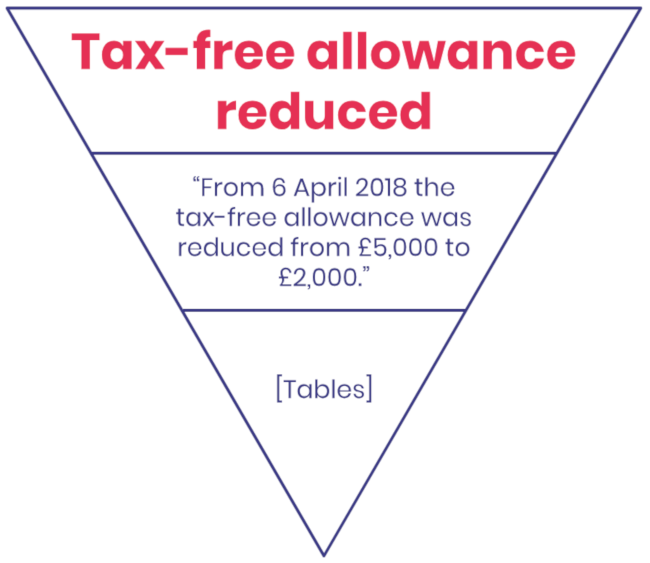Writing a post for your accountancy firm’s blog needn’t seem like an impossible challenge: there are some tricks, techniques and shortcuts for getting it done quickly and painlessly.
Even when accountants know they ought to write a blog post or article – even when they’re convinced of the value of content marketing – finding the time between billable jobs can feel impossible.
You’ve got to come up with an idea, do your research, and start writing. And that’s not the end of the process: there’s editing, proofreading, finding a suitable image, uploading, formatting…
What’s more, before long you’ll need to do it all again (nothing looks sadder than a corporate blog that hasn’t been updated since 2015) so it’s easy to see how this kind of thing keeps getting bumped down to-do lists.
But it can be done – you can write a 500-word blog post, from beginning to end, in 30 minutes. Let’s give it a go.
There’s a system
The writing process I follow is this:
1. Outline. Instead of jumping straight in, work out what you want to say and the order in which you want to say it, just as bullet points or notes. (5 minutes.)
2. Draft. Bash it out. If you get stuck type MORE HERE or CHECK LATER and just move on. The important thing is to get, say, 500 words, however ugly or imperfect, down on the page. (15 minutes.)
3. Edit. Review what you’ve written with a focus on the overall structure and clarity, rather than commas and spelling. A top tip here is to get someone else to look at it with fresh eyes. Alternatively, leave it for a day or two before editing yourself. (5 mins.)
4. Proofread. This is when you fix the details. Check the spelling of any words you’re not 100% sure about. Tips: get someone else to proofread if you can; otherwise, read it aloud and you’ll find previously invisible typos leaping out; also, try scanning it backwards. (5 mins.)
And that’s it, the hardest bit’s done.
Realistically, of course, you might treat yourself to more than 30 minutes, but even indulging yourself with an hour beats losing a full day.
Structural engineering
When it comes to step one above, outlining, there are some useful off-the-peg structures you can use to get yourself started.
First, there’s the inverted pyramid – a stone-cold classic often used by journalists for writing informational articles and news stories.
The idea here is that you start with the most important information and gradually supply more detail as the piece goes on.
Someone should get the gist from the headline, learn key facts from the introductory paragraph, and then find supporting evidence and quotes in the tail of the piece.

An example of the inverted pyramid, from summary to detail.
With the above structure in particular in mind, people sometimes talk about the fifty-fifty rule which says you should spend about as much time crafting the headline as you do on the rest of the copy altogether.
Another approach is the explainer, in three acts:
- Give the reader a summary of the topic.
- Tell them something they might not already know.
- Tell them what they ought to do about it.
Finally, there’s the much-derided listicle – not only easy to write and guaranteed to drive clicks but also a great way of making technical content more digestible. You’d want to read ‘Seven ways to reduce your tax bill’, wouldn’t you?
Flushing out writer’s block
Creativity is a funny thing.
You can sit struggling with writer’s block at your desk for hours but move to another location – a cafe, or even just a different corner of the office – and you might find that suddenly the words start flowing again.
If a screen isn’t working for you, try pen and paper. Oddly, this can sometimes unlock things, perhaps because it uses different mental muscles than typing, or because it forces you take things a bit more slowly.
If you hit a brick wall, grab a sympathetic colleague and try to explain out loud what you think you want to say. It’s amazing how often you’ll hear the perfect words – words you somehow couldn’t type – coming out of your mouth.
Finally, there’s the NaNoWriMo approach. NaNoWriMo is the short name for National Novel Writing Month for which, every November, people around the world commit to writing a 50,000-word novel in 30 days.
It’s an intense challenge but the idea isn’t to write a great novel, it’s to turn in the words, with the ticking timer focusing the mind.
Sometimes, limiting yourself can be really helpful, so try giving yourself just ten minutes to write a blog post and see what you can hammer out.
Perfect is the enemy of good
I think I can say this because my partner and brother are both accountants: the kind of people who thrive in this profession sometimes tend towards perfectionism.
That’s a great thing when you’re dealing with someone’s tax affairs but less helpful when you just need to get 500 words knocked out.
To put it bluntly, as long as it’s not technically inaccurate or full of typos, a less than perfect blog post that actually gets published is worth infinitely more than one that remains purely conceptual.
Maximum value from your writing
It’s worth remembering, too, that a single blog post has a long life, and can be squeezed for extra value.
A blog post doesn’t exist in a vacuum – it’s an engine for driving conversation on social media or elsewhere.
Once you’ve written it, you’ve got an excuse for a Tweet, a Facebook post, or a LinkedIn update. You can include it in your firm’s monthly newsletter, or even just email it to a couple of contacts you think might find it interesting.
Even after the initial flurry of clicks has died away, if your website is properly calibrated for SEO then a post will sit there quietly drawing in traffic, and potential leads, for years to come.
And remember, after a year or so, there’s nothing to stop you updating your post with new information and republishing it.
Keep at it
One final piece of good news: the more you write, the easier it gets. Even if the first blog post you write is a struggle, your tenth – I promise – will be a doddle in comparison.
Let us lend a hand
There are a few ways we can support you in producing content.
The first is with our white label content for accountants, which provide fully-finished, engaging material you can customise, or use for inspiration.
Our content workshops are a great way to kick-start a programme of content production, with our editorial team supporting you to put together a calendar of activity based on your firm’s communications priorities.
Finally, there’s the easiest option of all: let us do all the work through our tailored content service.
